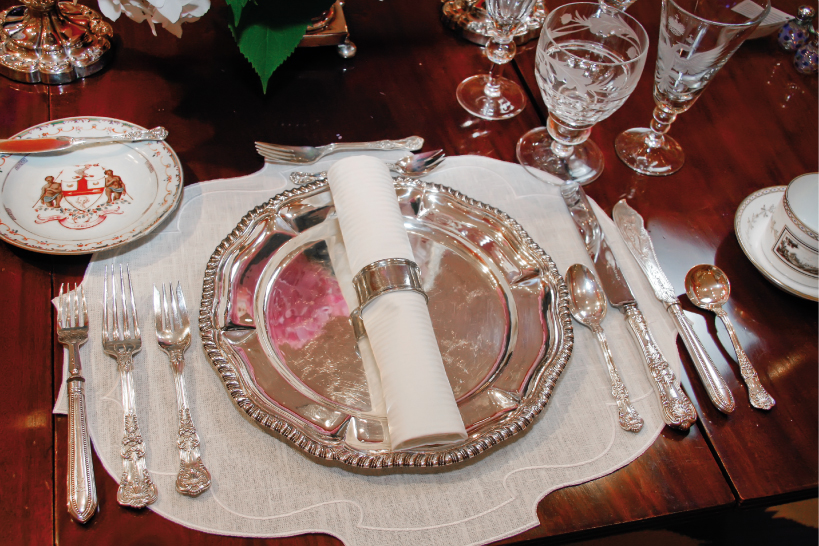Table Setting 101
 In medieval times, meals were served out of a communal pot placed on a table to which diners brought their own knife, spoon and a wooden board called a trencher. Forks were nonexistent and fingers were used to take food from the pot onto the trencher and into the mouth. Napkins were oversize, due to necessity.
In medieval times, meals were served out of a communal pot placed on a table to which diners brought their own knife, spoon and a wooden board called a trencher. Forks were nonexistent and fingers were used to take food from the pot onto the trencher and into the mouth. Napkins were oversize, due to necessity.
It was not until the 19th century that the service a la russe (a series of dishes served in succession) came into vogue as the precursor to our modern-day table. The table is kept bare of service dishes because food is plated in the kitchen or served from a buffet. Flower arrangements and candlesticks can be placed in the center of the table and dessert flatware becomes part of the table setting, because dessert is a part of the meal and not a separate affair.
To this day, dining remains one of the most basic forms of human interaction and dinner parties are an important way to entertain friends and family or to conduct business. Whether you are celebrating a homecoming, a holiday meal or just dinner for two, sharing a meal with the special people in your life is a grand occasion.
A Formal Dinner
A formal dinner is a special time — a meal to linger over as you enjoy the conviviality of the guests at your table. It is served in courses, each to be savored on its own merit, each plated and served individually. A formal dinner is the time to bring out your best china, crystal, silver and linens. You are going to great effort to prepare an unforgettable dinner that deserves to be presented in its very best light. Presentation is everything at a formal dining table.
Candlelight and fresh flowers add greatly to the ambience of the evening. Every bride should be given a pair of silver candlesticks on the occasion of her wedding. Those candlesticks, after sitting on the dining table as an observer at so many gatherings, would have quite a tale to tell after 50 years or so!
Your formal dinner will be served in courses, by you and your co-host or by staff. Each course will be served individually and the plates and corresponding wine glasses cleared before the next course is served. The Service Plate is the only plate that remains on the table between courses. This plate is larger than a dinner plate and can be used as a buffet plate on another occasion when you are hosting a buffet dinner party. Remember: when serving or removing each course: LOWER from the LEFT; REMOVE from the RIGHT.
 Yes, there will be a lot of dishes to wash and linens to iron, but it will be worth the effort and allow you and your co-host time to enjoy a “post-mortem” of an unforgettable evening.
Yes, there will be a lot of dishes to wash and linens to iron, but it will be worth the effort and allow you and your co-host time to enjoy a “post-mortem” of an unforgettable evening.
- THE APPETIZER COURSE
Soup and bread. Clear, broth soups are served in a handled soup bowl with a bouillon spoon. Creamy soups and stews are served in a rimmed soup bowl with a soup spoon. - THE FISH COURSE
The number of courses being served are indicated by the number of eating utensils on the table. Forks go on the left, and knives and spoons on the right. The dessert service is at the top of the plate. Generally speaking, utensils are used from the outside in.If different wines are being served, the appropriate number of goblets is set with the first wine to the far left and the ensuing wines lining up. In our menu, we are serving a white wine with the fish course, a red wine with the main course and champagne with the dessert. Goblets are removed as each course is finished. Whether or not your menu requires red or white wine, it is nice to offer both to your guests. - THE MAIN COURSE
(beef or lamb)
Served with red wine. - SALAD
Surprising to some, salad is served after the main course at a formal dinner. - DESSERT
Because dessert is a part of the meal, you’ll find dessert utensils on the table along with the appropriate drinkware if a special dessert beverage is to be served.
 An Informal Dinner
An Informal Dinner
This is the way most of us entertain and should be the way we dine as frequently as possible with our children. A step above casual, this says to our family that something happy has happened that we need to recognize…a birthday, a first soccer goal scored, a role in the school play…all times to sit down and create a memory. An informal dinner is a perfect way to gather with friends, even if the occasion is simply an opportunity to connect, interact and laugh at the end of the day.
Table linens can be more casual and the table setting is in the traditional manner because this meal is not served in courses. There is generally a bread and butter plate above the forks, a salad plate to the left of the forks and a cup and saucer (if coffee is to be served) to the right of the knives and spoons.
Since there are fewer courses, we use what is generally known as the five-piece place setting: salad fork (far left); dinner fork (left); dinner knife (right); teaspoon (far right); dessert spoon (above plate, handle to right). Also since there are fewer courses, you can get by with serving only one type of wine along with water. Both glass and goblet rest above the knife and spoon.
 A Casual Supper
A Casual Supper
First, “casual dining” does not mean eating food out of the carton! Picnics, poolside dinners and Sunday night kitchen suppers with good friends don’t mean dining shouldn’t be done with style. Here is where paper products and melamine shine. Set your table the same as you would for an informal dinner, using paper or plastic dinner plates and plastic glasses for drinks. Because plastic utensils are so hard to use, set the scene with your everyday stainless steel flatware and cutlery.






